阿宝哥精心准备的《轻松学 TypeScript》 视频教程已经更新到第十一期了,通过形象生动的动画,让你轻松搞懂 TypeScript 的难点和核心知识点!
你知道如何获取 T0 数组类型中元素的类型和 T1 函数类型中的返回值类型么?给你 3 秒钟的时间思考一下。
type T0 = string[];
type T1 = () => string;要实现上述的功能,我们可以使用 TypeScript 提供的类型模式匹配技术 —— 条件类型 + infer。条件类型允许我们检测两种类型之间的关系,通过条件类型我们就可以判断两种类型是否相兼容。而 infer 用于声明类型变量,以存储在模式匹配过程中所捕获的类型。
下面我们来看一下如何捕获 T0 数组类型中元素的类型:
type UnpackedArray<T> = T extends (infer U)[] ? U : T
type U0 = UnpackedArray<T0> // string在以上代码中,T extends (infer U)[] ? U : T 是条件类型的语法,而 extends 子句中的 infer U 引入了一个新的类型变量 U,用于存储被推断的类型。
为了便于大家的理解,我们来演示一下 UnpackedArray 工具类型的执行流程。
type U0 = UnpackedArray<T0>
// T => T0: string[]
type UnpackedArray<string[]> = string[] extends (infer U)[] ? U : string[]
// string[] extends (infer U)[] 模式匹配成功
// U => string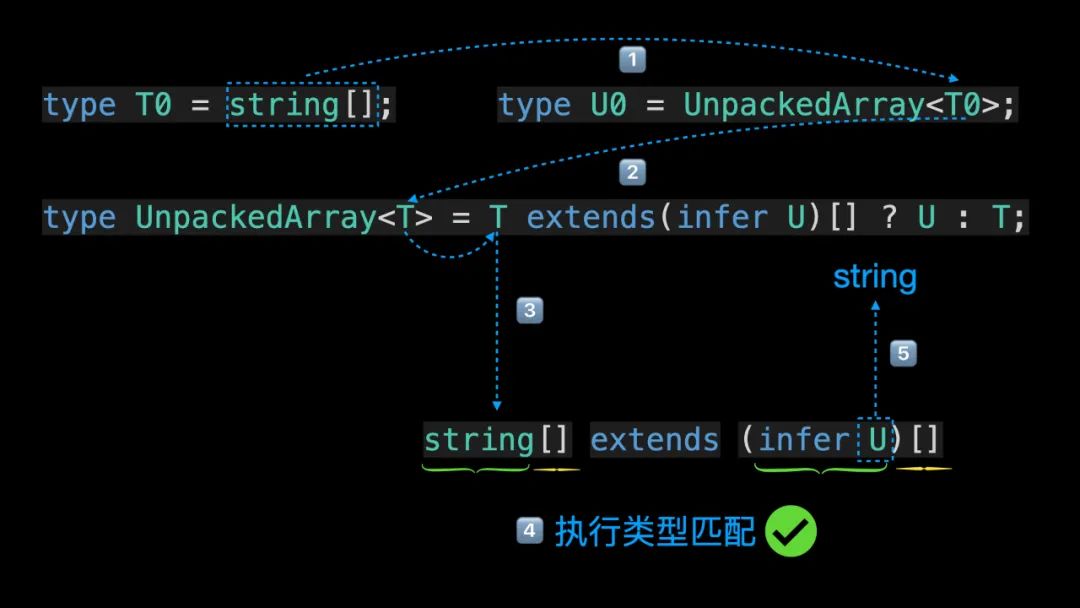
需要注意的是,infer 只能在条件类型的 extends 子句中使用,同时 infer 声明的类型变量只在条件类型的 true 分支中可用。
type Wrong1<T extends (infer U)[]> = T[0] // Error
type Wrong2<T> = (infer U)[] extends T ? U : T // Error
type Wrong3<T> = T extends (infer U)[] ? T : U // Error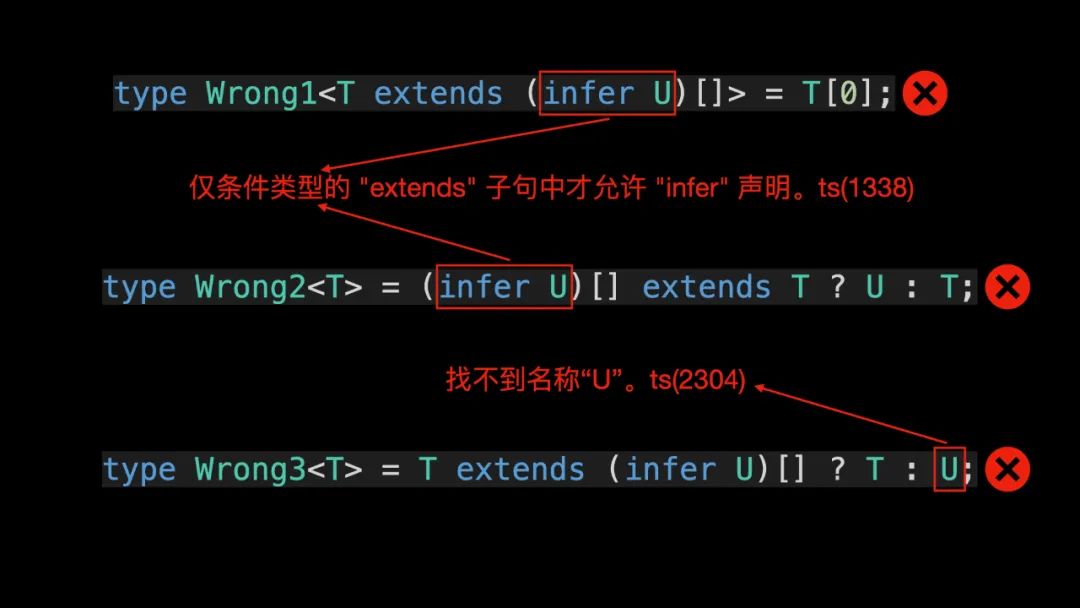
了解完这些知识之后,我们来看一下如何获取 T1 函数类型的返回值类型:
type UnpackedFn<T> = T extends (...args: any[]) => infer U ? U : T;
type U1 = UnpackedFn<T1>; // string看完 UnpackedFn 工具类型的实现,是不是觉得挺简单的。当遇到函数重载的场景,TypeScript 将使用最后一个调用签名进行类型推断:
declare function foo(x: string): number;
declare function foo(x: number): string;
declare function foo(x: string | number): string | number;
type UnpackedFn<T> = T extends (...args: any[]) => infer U ? U : T;
type U2 = UnpackedFn<typeof foo>; // string | number如果你对 TypeScript 的条件类型还不了解的话,建议观看 “用了 TS 条件类型,同事直呼 YYDS” 这篇文章。在该篇文章中,我们介绍了条件链,利用条件链我们可以实现功能更加强大的 Unpacked 工具类型。
type Unpacked<T> =
T extends (infer U)[] ? U :
T extends (...args: any[]) => infer U ? U :
T extends Promise<infer U> ? U :
T;
type T0 = Unpacked<string>; // string
type T1 = Unpacked<string[]>; // string
type T2 = Unpacked<() => string>; // string
type T3 = Unpacked<Promise<string>>; // string
type T4 = Unpacked<Promise<string>[]>; // Promise<string>
type T5 = Unpacked<Unpacked<Promise<string>[]>>; // string在以上代码中,Unpacked 工具类型利用了条件类型和条件链,轻松实现了推断出数组类型中元素的类型、函数类型返回值的类型和 Promise 类型中返回值的类型的功能。
其实,利用条件类型和 infer,我们还可以推断出对象类型中键的类型。接下来,我们来举个具体的例子:
type User = {
id: number;
name: string;
}
type PropertyType<T> = T extends { id: infer U, name: infer R } ? [U, R] : T
type U3 = PropertyType<User> // [number, string]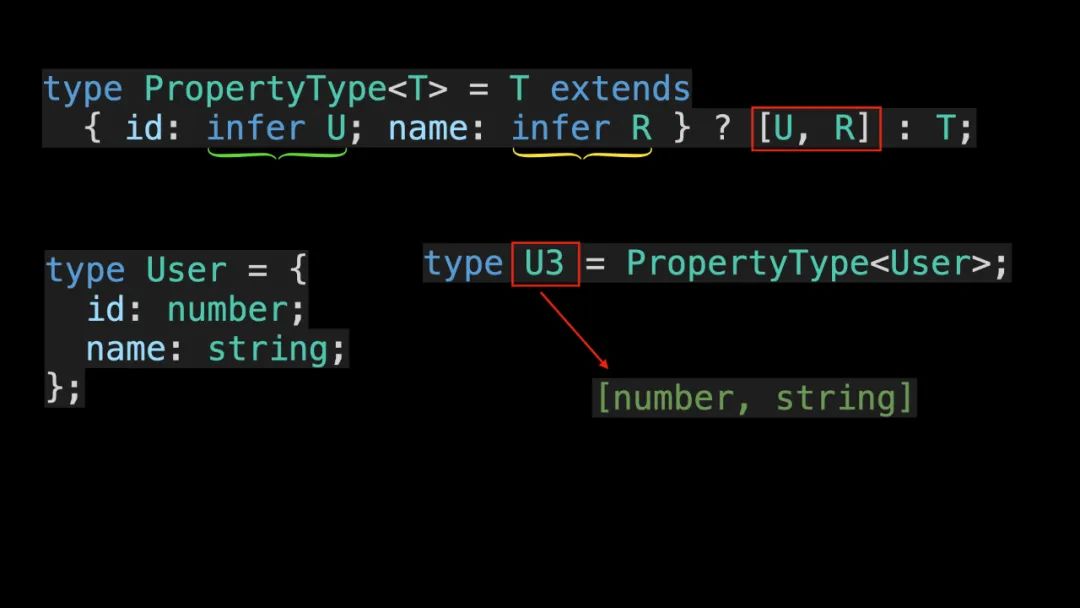
在 PropertyType 工具类型中,我们通过 infer 声明了两个类型变量 U 和 R,分别表示对象类型中 id 和 name 属性的类型。若类型匹配,我们就会以元组的形式返回 id 和 name 属性的类型。
那么现在问题来了,在 PropertyType 工具类型中,如果只声明一个类型变量 U,那结果又会是怎样呢?下面我们来验证一下:
type PropertyType<T> = T extends { id: infer U, name: infer U } ? U : T
type U4 = PropertyType<User> // string | number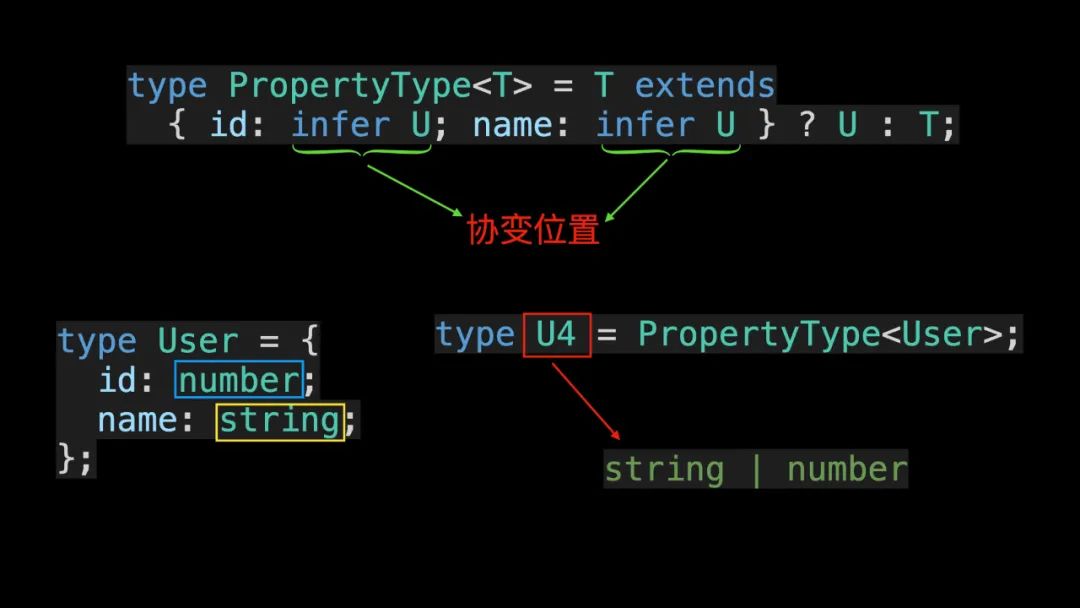
由以上代码可知,U4 类型返回的是 string 和 number 类型组合成的联合类型。为什么会返回这样的结果呢?这是因为在协变位置上,若同一个类型变量存在多个候选者,则最终的类型将被推断为联合类型。
然而,在逆变位置上,若同一个类型变量存在多个候选者,则最终的类型将被推断为交叉类型。同样,我们来实际验证一下:
type Bar<T> = T extends { a: (x: infer U) => void, b: (x: infer U) => void } ? U : never;
type U5 = Bar<{ a: (x: string) => void, b: (x: number) => void }>; // string & number
在以上代码中,U5 类型返回的是 string 和 number 类型组合成的交叉类型,即最终的类型是 never 类型。
看完本文之后,相信你已经了解条件类型和 infer 的作用了。那么你能看懂 UnionToIntersection 这个工具类型的具体实现么?
type UnionToIntersection<U> = (
U extends any ? (arg: U) => void : never
) extends (arg: infer R) => void
? R
: never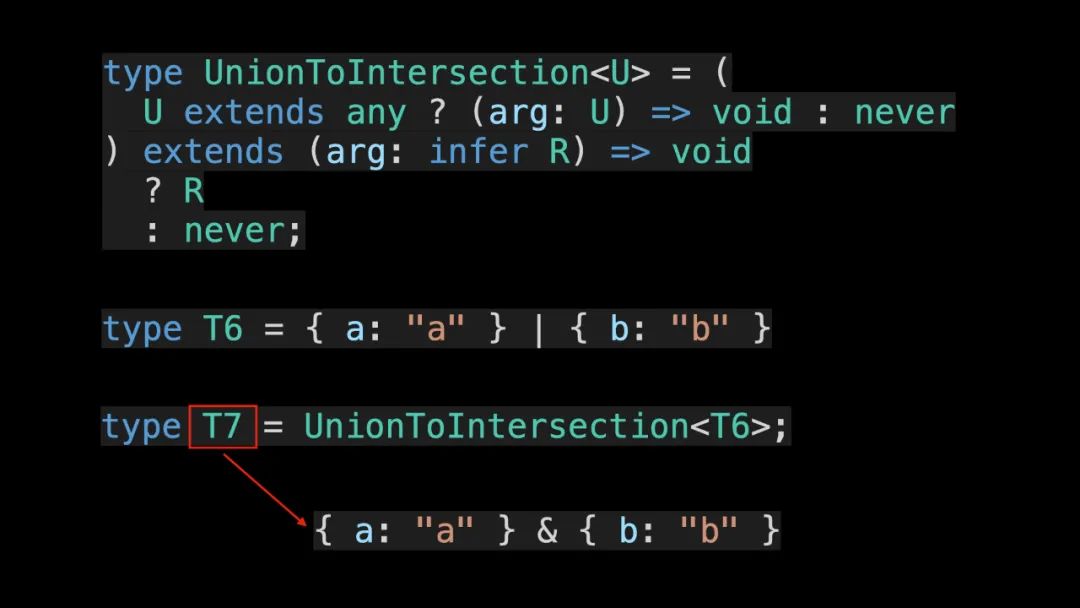
扫码查看 轻松学 TypeScript 系列视频教程

(目前已更新 11 期)
关于前面提到的协变和逆变,阿宝哥将在后续的文章中介绍,感兴趣的话记得关注阿宝哥。你喜欢以这种形式学 TS 么?喜欢的话,记得点赞与收藏哟。




















 8974
8974











 被折叠的 条评论
为什么被折叠?
被折叠的 条评论
为什么被折叠?








